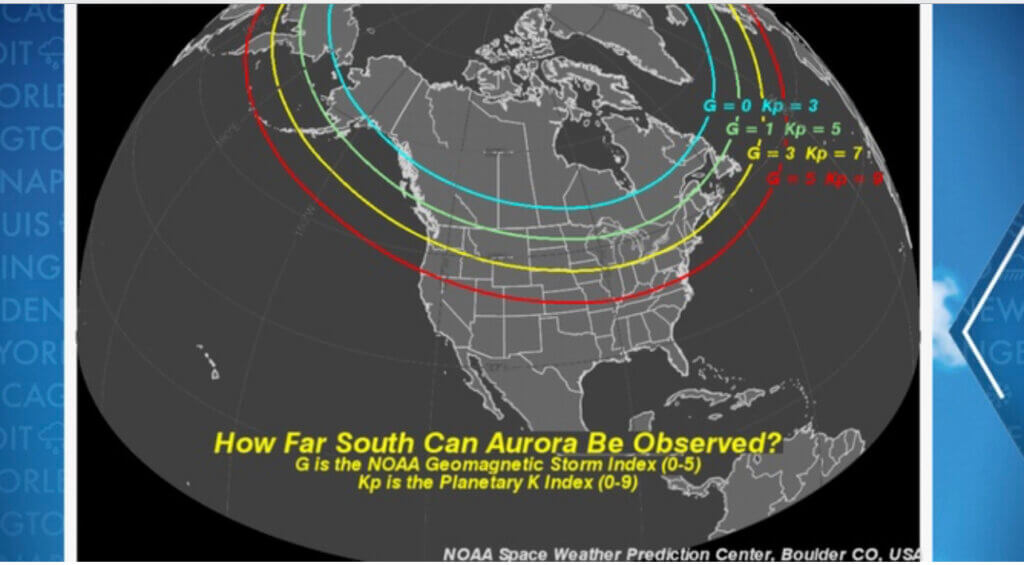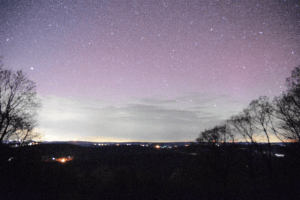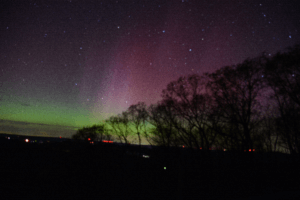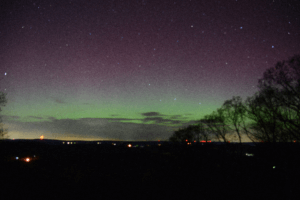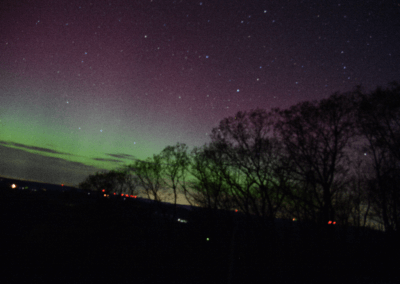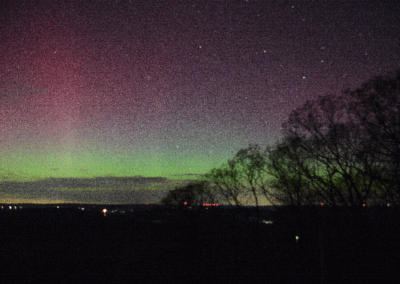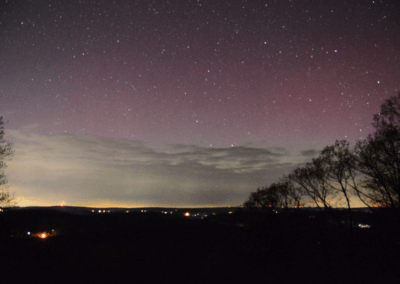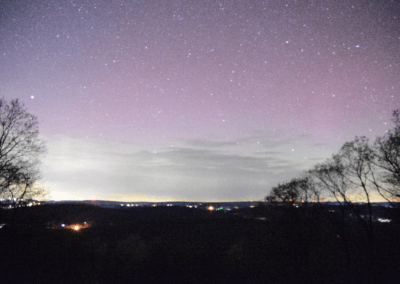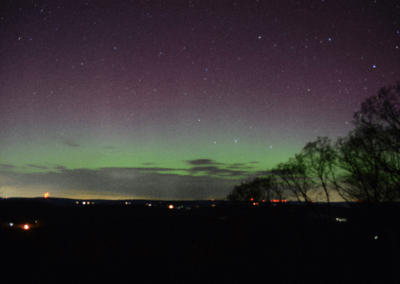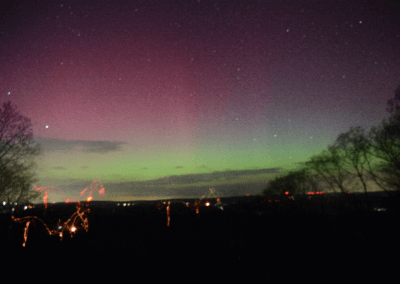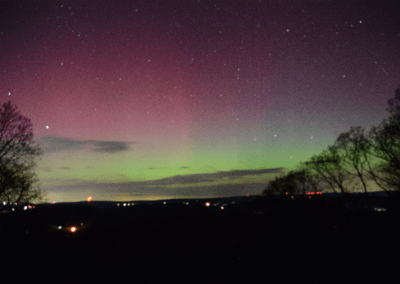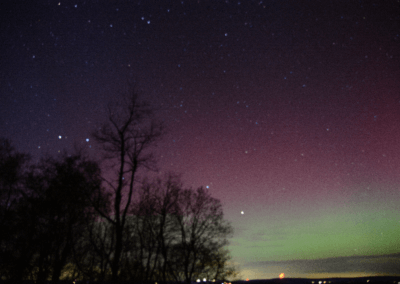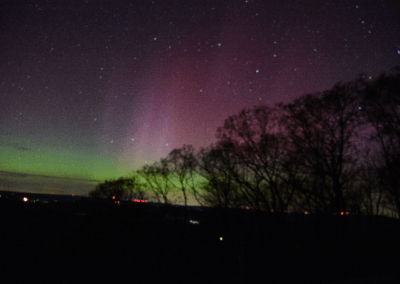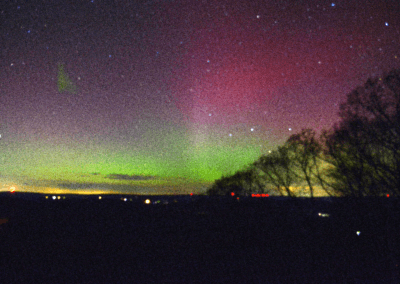I experienced the Northern Lights right here at Deep Creek Lake, MD!
Photographing the Northern Lights is an experience that many people dream of, but few have the opportunity to capture. It takes a combination of the right equipment, the right location, and the right timing to create stunning images of this natural wonder. In this post, I’d like to share the progression of photographing the Northern Lights at Deep Creek Lake, MD, and share some insight on this breathtaking phenomenon.
The Northern Lights, also known as Aurora Borealis, is a natural light display that typically occurs in the polar regions of the world. Specifically, in the United States, the “lights” are often seen in Alaska. However, on rare occasions, they can be seen much farther south, even as far south as our own Deep Creek Lake area in Western Maryland.
The reason for the show to be seen so far south is due to a severe geomagnetic storm, which is a disturbance in the Earth’s magnetic field, caused by strong solar winds. When these solar winds reach the Earth’s atmosphere, they can create a chain reaction of particle collisions that produce a much larger and more intense display of the Northern Lights than usual. During these times, the lights may be visible at much lower latitudes… remember, the atmospheric conditions also need to be favorable. IE- no clouds!
The map below was the one I saw that made me run out the door thinking I had a chance to see the Northern Lights here in Maryland.
When I first attempted to photograph the Northern Lights, I was unsure of what to expect. I had read countless articles on the subject and had spent hours researching the best camera settings, but I still felt unsure of myself and my equipment. As the sky darkened, I set up my camera and tripod and waited for the lights to appear.
At first, I wasn’t sure if I was getting any good shots. The lights were faint and sporadic, and I was struggling to find the right camera settings. Especially photographing the lights due-North, had me shooting over the federal corrections center in West Virginia. I kept telling my husband, “I think I see green here… do you see it? I guess I can just post it and let the internet correct me if it’s really nothing.”
But as the night wore on, the lights became more intense and more frequent through the camera’s magic. I continually adjusted my camera settings and took more shots, hoping that I was capturing the magic of the Northern Lights.
Almost instantly, my photos exploded with color! The Northern Lights were dancing across the starry sky in a spectacular display of green and pink hues. Now, since I knew where to look, I could see faint light beams and a green tinge on the horizon. I was in awe of the beauty that the camera was picking up and showing me. I set the camera up for 8-second exposures and to take a photo every 1 second just trying to capture the essence of this breathtaking phenomenon.
This is a panoramic photo that I stitched together from several 25-second images. This was taken at about 1:00am 4/24/23 from the overlook on Maryland Route 135. Deep Creek Lake is the first set of white lights at the edge of the trees on the left.
As the night went on, the lights continued to intensify, and I continued to shoot. I experimented with different camera settings and angles, trying to capture the Northern Lights in all their glory. I was amazed by how quickly the lights changed, and how they seemed to have a life of their own.
In the end, I was able to capture some stunning images of the Northern Lights. I was thrilled to have been able to witness this natural wonder and even more excited to share my photos with others.
Here’s what I learned in experiencing this phenomenon:
1 – Choose the right location: The Northern Lights are best seen in areas with minimal light pollution, such as remote wilderness areas or small towns. Check the weather forecast and aurora forecasts before heading out to ensure the best chance of seeing the lights. The pulloff along MD Route 135 was ideal for the show since there were no nearby lights and I could see the lights over a relatively flat horizon. I would have loved to capture the lights dancing over Deep Creek Lake but it was such a limited window for the display, I wasn’t sure I could get there in time. Maybe next geostorm!
2 – Use professional equipment: A camera with manual settings, a sturdy tripod, and a remote shutter release are essential for capturing the Northern Lights. A wide-angle lens with a fast aperture (f/2.8 or wider) will help you capture as much light as possible. I actually did not have “the right” lens but I was able to set the camera to manual mode and stitch together some of the photos to make the panoramic photo (above).
3 – Experiment with camera settings: There’s no one “correct” way to shoot the Northern Lights. Experiment with different shutter speeds, ISO settings, and apertures to find what works best for you. A good starting point is a shutter speed of 10-20 seconds, an aperture of f/2.8, and an ISO of 1600-3200. You can see in the gallery below that it was very much a guess and check approach and where I was able to fine-tune the photos as I went.
4 – Be patient: The Northern Lights are unpredictable, and there’s no guarantee that you’ll see them. Be prepared to wait for hours in the cold and dark, and don’t give up too soon. I was so happy to have the experience here at Deep Creek Lake, MD but I think I’d still like the experience of seeing them in Alaska!
While the Northern Lights may not always — or ever — be visible at Deep Creek Lake, the area still offers a wealth of attractions and activities that make it a fantastic destination for families and friends.
With its stunning natural beauty, picturesque surroundings, and variety of outdoor activities, Deep Creek Lake is a wonderful place to visit at any time of year. From hiking and fishing in the summer to skiing and snowboarding in the winter, there is always something to do and see in this beautiful part of the world.
Please email me if you have any questions!

